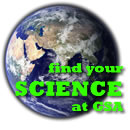REPORT |
Unlocking 3-D Earth Systems—Harnessing New Digital Technologies to Revolutionize Multiscale Geologic Models
Durham University, Durham, UK
17-21 September 2006
Conveners:
- Ken McCaffrey
- Reactivation Research Group, Department of Earth Sciences, University of Durham, South Road, Durham DH1 3LE, UK
- Jonathan Imber
- Reactivation Research Group, Department of Earth Sciences, University of Durham, South Road, Durham DH1 3LE, UK
- Nicolas Holliman
- e-Science Research Institute, University of Durham, South Road, Durham DH1 3LE, UK
- Bob Holdsworth
- Reactivation Research Group, Department of Earth Sciences, University of Durham, South Road, Durham DH1 3LE, UK
- John Howell
- Centre for Integrated Petroleum Technology, University of Bergen, Allegaten 41, Bergen N-5007, Norway
- Tim Wawrzyniec
- LiDAR Laboratory, Department of Earth and Planetary Sciences, Northrop Hall, University of New Mexico, Albuquerque, NM 87131-0000, USA
MEETING OVERVIEW
Earth systems are inherently four-dimensional and multiscale, requiring a geospatial approach to capture and model natural architectures. In September 2006, 50 participants from North America, Europe, and Australia, including 16 students, met at Durham University to discuss how new digital data capture and three dimensional (3-D) visualization technologies can improve our understanding of the uncertainty and geometric-spatial scaling in multiscale geologic models.
The conference began with a field trip to assess how to digitally capture, visualize, and analyze geological outcrops (in this case, the 90 Fathom fault, Cullercoats). Four groups addressed issues related to the conference themes, including scaling and dimensionality of geological structures, quantifying uncertainty in geological models, and capturing geological complexity. During the following four days of talks and "e-posters," participants discussed the application of digital technologies and stereo visualization to better understand outcrop- to plate-scale processes and for quantifying uncertainty in multiscale models. Participants were encouraged to show "live" datasets using immersive 3-D visualization in the talks and to use plasma screens in the poster sessions. Each day ended with a plenary discussion, and the conference closed with a two-hour panel-led wrap-up discussion.
High precision spatial data are now routinely acquired using laser scanning, photogrammetry, and/or global positioning-global information systems to create digital geospatial databases ("n-dimensional maps") that contain much more information — and associated metadata — than traditional paper maps. Covisualization of multiple attributes can be used to integrate different types of data across all scales. Such models permit spatial analysis and the use of geostatistics and thus go beyond just "pretty pictures." Virtual reality environments have the additional advantage of enhancing interaction both with the data and among users. Digital technologies also enable simple validation exercises during data acquisition (e.g., section balancing while mapping), increasing confidence in the final interpretation. In addition, careful use of digital technologies can provide improved understanding of the fourth (time) dimension to reconstruct the growth of geological architectures.
Geospatial models provide a platform to define and manage the many different types and magnitudes of uncertainty inherent in geoscience datasets. Uncertainty can be represented at each locality in the database as a compound function of spatial precision, measurement error, and geological interpretation (e.g., is it granite or limestone?). Interpretation is subjective and will depend on an individual's experience, age, bias, etc. Research shows that interpreters are more likely to arrive at the correct geological interpretation if they consider the geological processes rather than simply "drawing lines." Thus, the user's prior expert knowledge is a key component in any digital workflow.
An underlying benefit arising from geospatial data is that 3-D models can fundamentally improve how we communicate our science to industrial and academic users, students, and schools; hence, these models have great potential for raising the profile of the earth sciences within the wider community. End-users can interrogate digital datasets, which in turn gives them the ability to conduct their own scientific inquiries. These models are a great way to train high school teachers to teach fundamental scientific techniques, including data analysis and hypothesis testing. At the undergraduate level, digital mapping combined with 3-D visualizations in the field allow students to check correlations and hypotheses "on the fly," creating new opportunities for advanced fieldwork techniques.
MEETING CONCLUSION
Participants came to broad agreement on the need for the digital geology group to become a more visible, coherent community, with the aim of facilitating the paradigm shift that appears to be changing the way geoscientists collect and analyze data. Specifically, there should be greater sharing of best-practice workflows, raw data, and open source software. A volume of papers presented at the meeting is forthcoming and a Web site will be developed. It was agreed that a ground-based LiDAR archive should be established, with a view to obtaining long-term funding (cf. airborne LiDAR archive). Many participants felt that uncertainty was the next "big issue" to tackle using digital technology, while others pointed out that we need a list of "digital success stories," both in terms of academic scientific achievement and commercial benefits. These issues will be developed in a series of follow-up workshops and symposia.
Participants:
Carlos Aiken |
Alan Gibbs |
Mariana Olariu |





